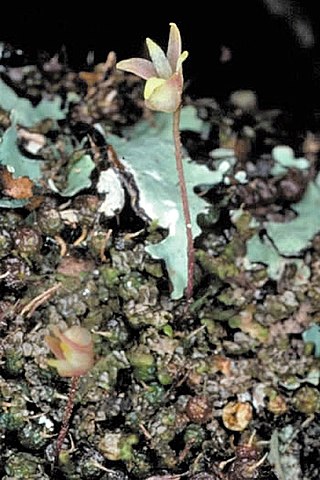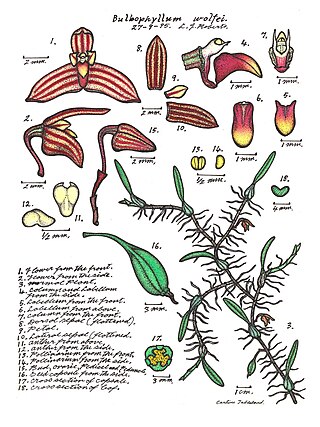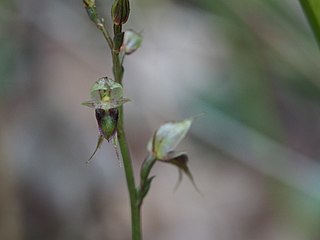
Bulbophyllum is a genus of mostly epiphytic and lithophytic orchids in the family Orchidaceae. It is the largest genus in the orchid family and one of the largest genera of flowering plants with more than 2,000 species, exceeded in number only by Astragalus. These orchids are found in diverse habitats throughout most of the warmer parts of the world including Africa, southern Asia, Latin America, the West Indies, and various islands in the Indian and Pacific Oceans. Orchids in this genus have thread-like or fibrous roots that creep over the surface of trees or rocks or hang from branches. The stem is divided into a rhizome and a pseudobulb, a feature that distinguished this genus from Dendrobium. There is usually only a single leaf at the top of the pseudobulb and from one to many flowers are arranged along an unbranched flowering stem that arises from the base of the pseudobulb. Several attempts have been made to separate Bulbophyllum into smaller genera, but most have not been accepted by the World Checklist of Selected Plant Families.

Bulbophyllum globuliforme, commonly known as the green bead orchid, miniature moss-orchid or hoop pine orchid, is a species of epiphytic orchid with tiny spherical pseudobulbs, scale-like leaves and small cream-coloured flowers with a yellow labellum. It grows on the scaly bark of hoop pine, mostly on the McPherson Range on the New South Wales/Queensland border in eastern Australia. Because of its small size it is often dismissed as moss.

Rhizanthella, commonly known as underground orchids, is a genus of flowering plants in the orchid family, Orchidaceae and is endemic to Australia. All are leafless, living underground in symbiosis with mycorrhizal fungi. The inflorescence is a head of flowers held at, or just above the ground but mostly covered by soil or leaf litter and little is known about the mechanism of pollination.

Acriopsis, commonly known as chandelier orchids or 合萼兰属 is a genus of flowering plants in the family Orchidaceaes. Orchids in this genus are epiphytic herbs with spherical or cylindrical pseudobulbs, creeping, branched rhizomes, thin white roots, two or three leaves and many small flowers. The flowers are non-resupinate with the lateral sepals joined along their edges and have spreading petals and a three-lobed labellum. The column has projections that extend hood-like beyond the anther.
Bulbophyllum argyropus, commonly known as the silver strand orchid, is a species of epiphytic or sometimes lithophytic orchid that is endemic to eastern Australia, including Lord Howe and Norfolk Islands. It has crowded pseudobulbs, tough, dark green leaves and up to four small whitish to yellowish flowers with an orange labellum.

Bulbophyllum baileyi, commonly known as the fruit fly orchid, is a species of epiphytic or lithophytic orchid that is native to Queensland and New Guinea. It has coarse, creeping rhizomes, curved, yellowish pseudobulbs with a single thick, fleshy leaf, and a single cream-coloured flower with yellow, red or purple spots. It grows on trees and rocks in open forest, often in exposed places.
Bulbophyllum evasum, commonly known as the creeping brittle orchid, is a species of epiphytic or lithophytic orchid with creeping brittle rhizomes, small, stubby pseudobulbs and dark green, fleshy leaves. The flowers are small, pink to reddish with dark stripes and yellow tips, clustered on the end of a dark red flowering stem. This orchid grows in rainforest on tree trunks and branches as well as on rocks, in tropical North Queensland.

Bulbophyllum exiguum, commonly known as the tiny strand orchid, is a species of epiphytic or lithophytic orchid that is endemic to eastern Australia. It has small, roughly spherical pseudobulbs each with a single leaf and up to three small creamy white to yellow flowers emerging from the base of the pseudobulb. This orchid grows in rainforest and dry forest where it often covers the branches of trees or rocks on which it grows.

Bulbophyllum gadgarrense, commonly known as the tangled rope orchid, is a species of epiphytic orchid with small pseudobulbs hidden beneath purplish brown bracts, dark green, grooved leaves and small white flowers with orange or yellow tips. It grows on rainforest trees in tropical North Queensland.

Bulbophyllum grandimesense, commonly known as the pale rope orchid, is a species of epiphytic orchid with well-spaced pseudobulbs and brown bracts arranged along the stems. Each pseudobulb has a single, fleshy, dark green leaf and usually only a single white flower with thread-like tips on the sepals. It grows on rainforest trees in a small area of tropical North Queensland.
Bulbophyllum johnsonii, commonly known as the yellow snake orchid, is a species of epiphytic or lithophytic orchid that has a thin, creeping rhizome with flattened pseudobulbs, each with a single tough, dark green leaf and a single bright yellow to orange flower on a thread-like stalk. It grows on trees, shrubs and rocks in and near rainforest in tropical North Queensland.
Bulbophyllum lamingtonense, commonly known as the cream rope orchid, is a species of epiphytic or lithophytic orchid with well-spaced pseudobulbs and brown bracts arranged along the stems. Each pseudobulb has a single, fleshy, channelled leaf and a single cream-coloured or white flower with yellow tips. It grows on trees and rocks near cliffs and the edge of rainforest near the eastern border between New South Wales and Queensland.
Bulbophyllum lewisense, commonly known as the Mount Lewis rope orchid, is a species of epiphytic orchid with pseudobulbs and pale brown bracts arranged along the stems. Each pseudobulb has a single, dark green, channelled leaf and a single white flower with pointed tips on the sepals. It grows on the higher branches of rainforest trees, often where it is exposed to breezes on the higher tablelands of tropical North Queensland.
Bulbophyllum macphersonii, commonly known as eyelash orchids, is a species of epiphytic or lithophytic orchid that is endemic to Queensland. It has tiny, crowded, slightly flattened, dark green pseudobulbs, a single thick, fleshy leaf and a single dark red to purplish red flower with a narrow labellum. It grows on trees and rocks in sheltered places.
Bulbophyllum minutissimum, commonly known as the red bead orchid or grain-of-wheat orchid, is a species of epiphytic or lithophytic orchid with small, flattened, reddish or green pseudobulbs, scale-like leaves and small whitish to reddish flowers with broad dar red stripes. It grows on trees and rocks, mostly in swamps and near streams in eastern Australia.
Bulbophyllum windsorense, commonly known as the thread-tipped rope orchid, is a species of epiphytic orchid that has small pseudobulbs partly hidden by brown, papery bracts. Each pseudobulb has a single fleshy, dark green, grooved leaf and one or two cream-coloured or greenish flowers. It mainly grows near the breezy tops of trees, especially Callitris macleayana trees and is endemic to tropical North Queensland.

Bulbophyllum wolfei, commonly known as the fleshy snake orchid, is a species of epiphytic or lithophytic orchid with thin, creeping rhizomes, and flattened pseudobulbs each with a single thick, fleshy, dark green leaf and a single cream-coloured flower with dark red stripes. It mostly grows on rainforest trees in tropical North Queensland.

Dendrobieae is a tribe in the subfamily Epidendroideae, in the family Orchidaceae. The Dendrobieae are mostly tropical, epiphytic orchids which contain pseudobulbs.

Acianthus collinus, commonly known as hooded mosquito orchid or inland mosquito orchid, is a species of flowering plant in the orchid family Orchidaceae and is endemic to south-eastern continental Australia. It is a terrestrial herb with a single, heart-shaped leaf and between two and nine translucent pinkish flowers with reddish markings and is found growing in colonies on sheltered slopes in open forest in on the western slopes of the Great Dividing Range.

Acianthus exiguus, commonly known as tiny mosquito orchid, is a flowering plant in the orchid family Orchidaceae and is endemic to New South Wales in Australia. It is a terrestrial herb with a single, heart-shaped leaf and up to five translucent greenish-white flowers with pinkish markings and is found growing in forests on the north coast of the state.











